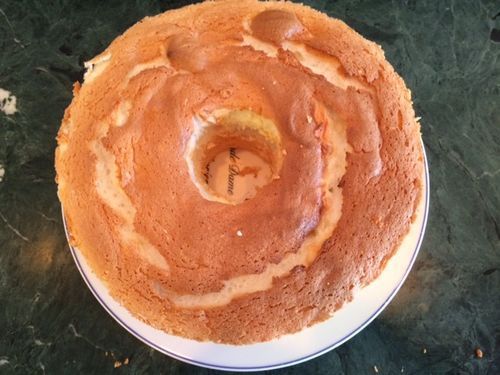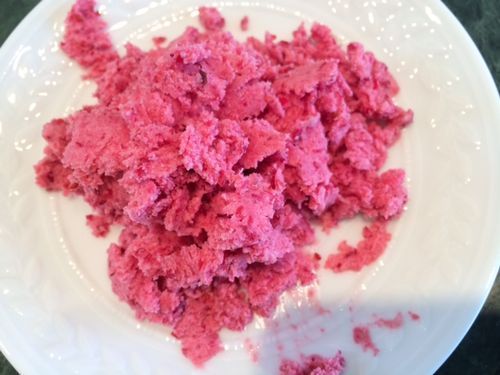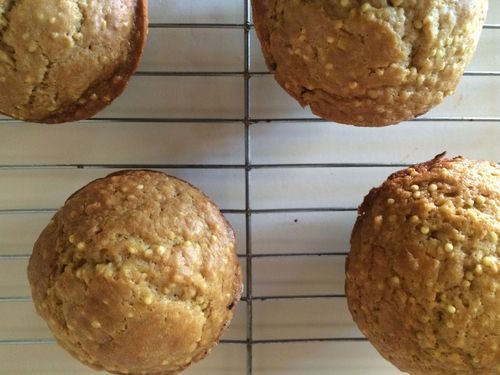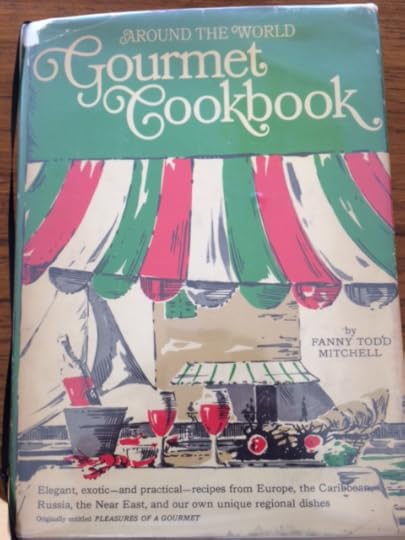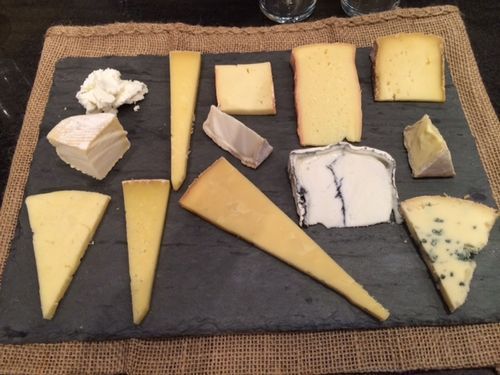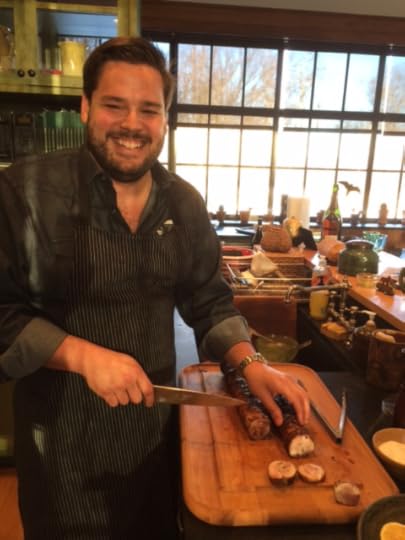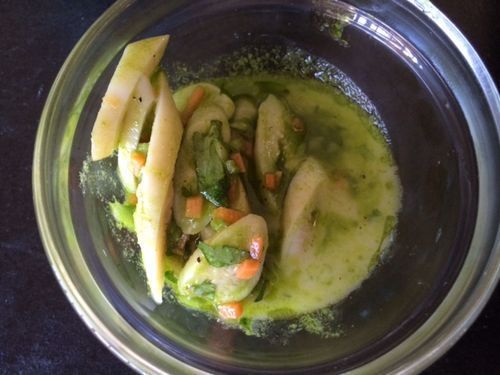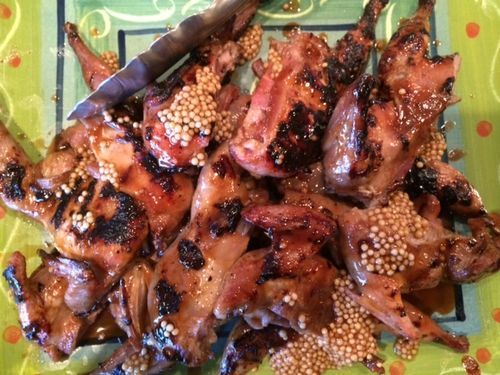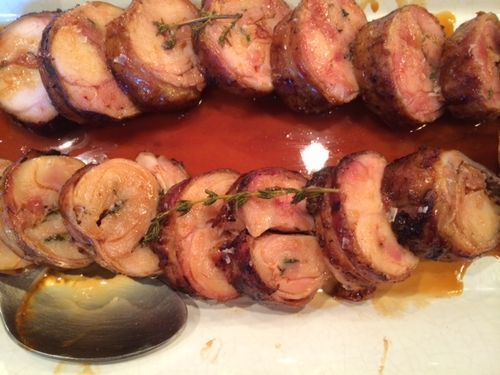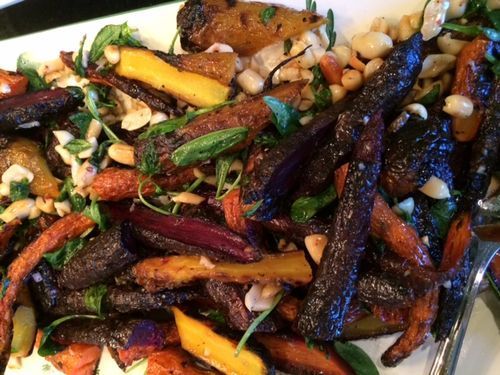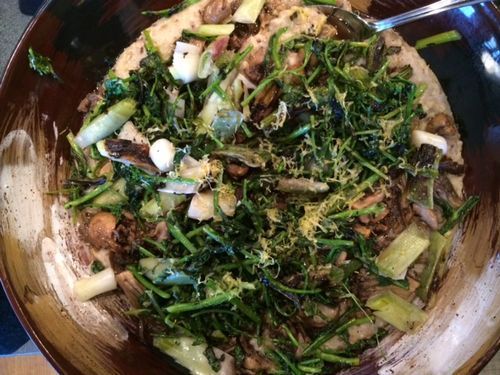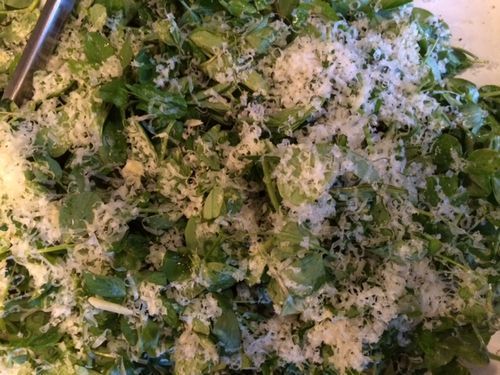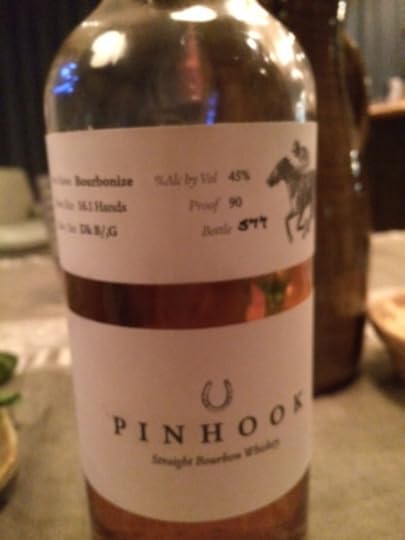Ruth Reichl's Blog, page 12
April 4, 2015
What Angels Eat
Had a dozen egg whites saved - been making a lot of lemon tarts lately - so last night I decided to make an angel food cake.
I'd forgotten how satisfyingly beautiful they are - all high and white - and what a pleasure the texture is. Pure sponge.
When my friend Marion Cunningham was working on the Baker’s Dozen Cookbook, she sent a recipe for the classic cake to thirty-five bakers, asking them each to bake the cake, exactly as written, and bring it to a meeting. She called me afterward in great excitement; “You would not believe how different they were,” she marveled. “They all had holes in the middle, but other than that, each cake was unique.”
Appalled by this, she and the other bakers decided to perfect the recipe. This cake, created by Flo Braker, is angel food perfection. Follow these instructions and you will have a high, white cloud-like confection that truly does seem food fit for angels.
Five Steps to a Better Angel Food Cake
Cold eggs are easier to separate, so do it when the eggs are right out of the refrigerator.
If even the tiniest amount of fat gets into the eggs they will refuse to whip. So separate each egg white into its own bowl before adding it to the others, in case one of the yolks breaks.
Leave your egg whites out of the refrigerator, for about an hour. If you have an instant-read thermometer, the optimum temperature is 60 degrees. The whites are more viscous at this temperature, and the air bubbles more stable. (Room temperature is about 70 degrees; they will whip more quickly, but at this temperature they are easy to over-beat.)
To insure there's no grease on the bowl or beater, wipe them with white vinegar and rinse in very hot water. Dry well.
Make sure your oven is 350 degrees. If the oven’s too low, the sugar will absorb the liquid from the egg whites and turn syrupy. If it’s too hot, the outside will set before the interior.
Allow the cake to cool completely before removing it from the pan.
Angel Food Cake (From Baker’s Dozen Cookbook)
12 large egg whites
1 1/2 cups sifted confectioner’s sugar
1 cup sifted cake flour
1/2 teaspoon salt
1 1/2 teaspoons cream of tartar
1 cup granulated sugar
1 teaspoon vanilla.
Allow the egg whites to sit in the bowl of a stand mixer for about an hour, to come to just above room temperature (70 degrees).
Sift the confectioner’s sugar, cake flour and salt together.
Whip egg whites at low speed until they are foamy. Add the cream of tartar and increase the speed to medium. Keep whipping, gradually adding the cup of granulated sugar, until the whites thicken and form soft, droopy peaks. Add vanilla.
Sprinkle a quarter cup of the flour mixture over the whites and fold it in, by hand, with a rubber spatula. Repeat with the next quarter, and the next, until all the flour has all been gently folded in. Pour into an ungreased 10-inch tube pan.
Bake at 350 degrees, 40 to 45 minutes, until the top is golden, the top springs back when you touch it, and a toothpick comes out clean. Invert the pan onto the neck of a bottle. Leave for 2 hours so that the cake is completely cool.
Run a knife around the sides of pan until you feel it release. Then push up the bottom of the pan. Loosen the cake bottom by tapping on a counter until it’s free and invert onto a plate, and then back onto a cake platter.
Slice with a serrated knife.
Lagniappe
Waiting for the cake to cool - there's something wonderful about the way you hang these upside down- I realized it might want some sort of embellishment. Ice cream? Looked in the freezer, and found we had none.
But I did find a package of frozen cranberries still lingering from Thanksgiving, that gave me an idea. What if I made a quick frozen cream with that? Would it work?
Basically I poured half a package of the frozen berries into a blender, added a few tablespoons of sugar and about a cup of heavy cream, and kept blending and tasting til the balance seemed right. Tart and creamy, it was the perfect accompaniment to this cake.
April 3, 2015
Only Elizabeth David.....
Been reading Elizabeth David's wonderful An Omelette and a Glass of Wine, as I prepare for a workshop at the Iceland Writer's Retreat next week. So much great stuff here. This particular sentence stopped me cold:
“I can only say that there are times when one positively craves for something totally unsensational; the meals in which every dish is an attempted or even a successful tour de force are always a bit of a trial.”
A little bit later I came upon this recipe for an extremely unsensational chick pea salad. Intriguing: it's basically hummus without the tahini, and without being pureed. (And I'm curious about that tablespoon of flour. What's that doing there?)
Elizabeth David’s Salade de Pois Chiches
Soak 1/2 lb. of chick peas overninght in plenty of cold water into which you stir a tablespoon of flour. Next day put them in a suacepan with the same water, plus a half teaspoon of baking soda. Simmer them for an hour. Skim and strain.
Rinse out the saucepan, fill it with 3 pints fresh water, bring to the boil, add a tablespoon of salt, put in the chick peas and simmer another 1 to 2 hours until the peas are perfectly tender and the skins beginning to break.
Strain them (keep the liquid - it will make a good basis for a vegetable soup), put them in a bowl and while still hot stir in plenty of olive oil, sliced onion, garlic, parsley and a little vinegar.
April 2, 2015
Wake Up Crunch
Millet's Moment
Texture matters to me. I'm intrigued when foods are so soft and smooth they seem to melt in your mouth. I'm enchanted with foods that vaporize when you take a bite. And I love it when a crunch resonates inside your head.
Seeds are especially appealing to me. I like the snap of pepitas in salad and the crackle of poppy seeds scattered on a bagel. Little wonder that the first time I went to Cafe Fanny in Berkeley and found their millet muffins, I was hooked.
Millet, star of these muffins, isn't a seed of course, but in this country it's used mostly for birdseed. Much of the rest of the world, however, considers it a staple; historically it's been eaten longer than rice. It is also, apparently, a good crop for arid regions. And given the state of water in California, it might be time we got to know it better.
These muffins use millet to add a spirited crunch to what are essentially straightforward buttermilk muffins. Serve them hot out of the oven, with plenty of the best butter you can find.
(This recipe is slightly modified from former Chez Panisse Chef Joanne Wier’s recipe, found on her blog.)
MILLET MUFFINS
1 egg
3/4 cup brown sugar
1/3 cup melted butter
12 tablespoons millet, broken up a bit - but not pulverized - in a food processor.
2 cups flour
1 teaspoon baking powder
3/4 teaspoon baking soda
1/4 teaspoon salt
1 cup buttermilk
Preheat an oven to 375 degrees.
Beat the egg and brown sugar well with an electric mixer.
Add the melted butter and 1/2 cup of buttermilk.
Stir in the millet. (If you’re making your batter ahead of time, be sure to wait until right before baking to add the millet. Let it sit, and it'll get soggy and you’ll lose the lovely crunch.) Sift the flour, baking powder, baking soda and salt together and add to the other ingredients.
Add the other 1/2 cup of buttermilk. Don’t overmix! Place in greased muffin tins.
Bake in the oven for 20 minutes, or until golden and a tester comes out clean.
Makes 12 muffins.
March 31, 2015
Another Intriguing Recipe
Been perusing old cookbooks this morning, just for the sheer pleasure of it. I came upon this recipe, that I have to try soon, before the snow melts and it's too warm for filling food. But to me Onion Custard looks like a wonderful substitute for Creamed Onions, which always drive me crazy; peeling onions is tedious work, and the result never seems quite worth.
This, on the other hand, looks easy, although I'm not sure I'd include the bacon. (If you get to it before I do, please let me know how the onions come out.)
Fanny Todd Mitchell's Onion Custard
1 pound white onions
1/2 stick butter
4 tablespoons heavy cream
3 eggs
1/2 teaspoon nutmeg
salt, pepper
1 strip lean bacon.
Peel onions and let stand in cold, salted water for 1 hour. Slice them and saute in butter until soft; don't brown. Cool them and preheat oven to 350 degrees.
Beat eggs, add cream. Season with nutmeg, salt, pepper and mix with onions. Pour into buttered casserole or baking dish. Slice bacon in tiny strips and lay on top.
Bake until the custard is thick, about 20 minutes.
Serves 6.
March 28, 2015
A Slightly Mad Recipe
Nancy Silverton's Pan Cotto
This is another crazy recipe Nancy asked me to test for her. It's a vegetable dish she discovered in a restaurant in Italy, and she plans to include it in her forthcoming cookbook. Knowing Nancy, who never stops tweaking recipes, it will be considerably changed by then. But this version, which I made for friends last night, was such a hit that I feel compelled to share it.
Warning: it's a fairly time-consuming and cheffy recipe. And it has some of the strangest recipe instructions I've ever encountered. It is also unlikely to come out in the smooth pancake (think hash brown potatoes) that she intends - but hash browns rarely turn out in a perfect pancake either. Doesn't really matter; what you will end up with is something crisp, slightly salty, and utterly irresistible.
Note: Nancy says you need a 9-inch non-stick sauté pan to make this. I used a 10-inch pan, and it worked fine. The more non-stick, I'd say, the better.
1 pound broccolini (about 2 bunches; or broccoli di ciccio)
2 tablespoons plus ½ teaspoon kosher salt (I cut this in half and it was still fairly salty)
4 arbol chile pods (I didn't have these, and it was fine)
½ to 1 teaspoon red chile flakes (depending on how spicy you like your food)
6 ounces country bread without the crust; crusts cut off; weighed without the crust (It's about half a loaf of Ciabatta or a round white loaf)
¼ cup garlic cloves (10 to 12 medium cloves), thinly sliced. (I cut this in half.)
½ cup extra-virgin olive oil
Trim and discard the dry stem ends of the broccolini. Separate the florets and the stems, then slice the stems in half lengthwise and cut them into 2-inch long segments. (Basically you're cutting the broccolini into fairly small pieces.)
Combine 2 quarts of water in a medium saucepan with a tablespoon of salt and chile pods and bring the water to a boil over high heat. Add the broccolini, return the water to a boil, and cook 3 minutes. Turn off the heat. Fish the broccolini out of the water and transfer it to a large bowl, reserving the cooking water in the pot. (This is important; you're going to need that water.) Discard the chile pods. Toss in the chile flakes.
Trim the crusts off the bread and cut it into ¼-inch cubes. (This will take longer than you think.) Put the bread cubes into a medium bowl. Add the olive oil, garlic, and salt and toss to coat the bread.
Pour 1 tablespoon of olive oil into a 9 or 10-inch non-stick sauté pan. Add the bread, along with all the garlic and oil, spreading into an even layer in the pan. Turn the heat to high and cook until you hear the oil begin to sizzle, 3 to 4 minutes. Continue to cook the bread over high heat, swirling the pan often and gently stirring the bread once or twice, so the bread doesn’t stick to the pan, 3 to 4 minutes more. Add the broccolini, mixing it into the bread so that it's evenly dispersed. Reduce the heat to medium, add ¾ cups of the reserved broccolini cooking water and swirl the pan again to prevent the bread from sticking.
Here's the strange part: put the pot (with the cooking water still in it), directly on top of the broccolini and bread to weigh it down. Cook in this fashion for 4 minutes, until it's all turned into a kind of mushy pancake. Remove the pot of water and reduce the heat to medium-low. Now take a metal spatula and begin pressing on the pancake, from the center out (the edges will become higher than the center), doing this every few minutes for about 20 minutes, until you hear the oil in the pan begin to sizzle. (What you're doing is cooking the water off.)
Swirl the pan every few minutes to try and prevent the bread from sticking to the pan (although in my experience this is fruitless). After the water has cooked off and the oil is really singing, increase the heat to medium and cook the pancake, swirling the pan and pressing on the pancake, until the pancake is golden brown and crisp, another 5 minutes or so.
Now turn off the heat, slide the pancake onto a dinner plate, cover it with another one and flip it over so the crisp side is on top. Slice into 6 or 8 wedges, like a pie.
Or just cover the pan with a dinner plate and flip it out of the pan. If it resists, don't worry; even if it's a scraggly mess instead of a serenely perfect pancake, it will be extremely delicious.
I'm sorry I forgot to take a picture, but when I rushed it to the table it smelled so wonderful we had devoured it before I had a chance to get my camera out.
March 27, 2015
Things I Love: Drinking Vinegar

People have been fermenting fruit into alcohol since the beginning of civilization. It follows, then, that old alcohol - vinegar - has been a staple of our diet for at least as long. The Mesopotamians made vinegar from dates, the Romans made vinegar from grapes, and from China to Greece, nearly every other kind of fruit has been discovered in vinegar form at the bottom of some ancient barrel.
So why does it feel fresh to see drinking vinegars being produced in this country? Everything old is new again - again. Long popular in Japan and Korea, and of course important to some niches in shrub and switchel form, drinking vinegars provide a perfect counterpoint to rich meals. Just mix a tablespoon or two with a bit of sparkling water. Or if so inclined, add a jigger of vodka.
I’m besotted with the shiso offering from Genki-Su, a company that makes Japanese-style coconut vinegar-based drinking vinegars. It’s also worth checking out the Pok Pok line; theirs was the first drinking vinegar I ever tried, and I've had at least one of their bottles in my cupboard ever since.
March 26, 2015
The Cherry Bombe Jubilee
It takes place this Sunday.
The Day’s Schedule 9:30 – 10:30 am: Breakfast and Registration
10:30 am – 12:30 pm: Session 1
Welcome by Kerry Diamond and Claudia Wu
Truly Share a Meal with Lauren Bush Lauren
Being a Leader: Rooted in Authenticity with Karen Kelley
The New Food Revolution: Three Stories with Caroline Randall Williams, Michelle Tam, and Danielle Walker. Moderated by Michele Promaulayko. Introduction by Andie Mitchell.
In Conversation: Ina Garten, with Julia Turshen
12:30 – 1:45 pm: Lunch, presented by Sweetgreen
1:45 – 3:30 pm: Session 2
Change the World, One Bite at a Time with Tanya Holland, Martha Hoover, and Jordyn Lexton. Moderated by Vivian Howard.
Listen to Your Deepest Self with Padma Lakshmi. Introduction by Jordana Rothman.
Meet the Modernists with Dominique Crenn, Elise Kornack, Iliana Regan, and Anjana Shanker. Moderated by Aki Kamozawa. Introduction by Charlotte Druckman.
3:30 – 4:15 pm: Snack Break, curated by Elly Truesdell of Whole Foods Market
4:15 – 5:30 pm: Session 3
Feel Your Way to Success with Erin McKenna
Keynote Conversation: April Bloomfield, with Gail Simmons. Introduction by Mimi Sheraton.
*Lineup is subject to change
March 25, 2015
Say Cheese!
Took a fascinating cheese class last night with Matt Rubiner, of Rubiner's Cheese in Great Barrington.
I don't think I've ever eaten so much cheese. And I learned a lot.
This class was a romp up Route 7 from Monterey, Massachussetts (Rawson Brook Farm), to Highgate, Vermont (Boucher Farm). Matt says this is now the densest cheese route in America, and who am I to disagree?
The cheeses we ate were delicious; high points, for me, were the sweet, simple Rawson Brook Farm Chevre, which is about as basic as cheese can be. I also loved the Dorset from Consider Bardwell Farm, the Crawford from Twig Farm and the rather remarkable Orb Weaver Old, from Orb Weaver Farm, which had a sweet, honest earthy quality. But we weren't just tasting cheese. Among the fascinating facts I learned last night:
Everything we thought we knew about cheese changed a few of years ago when a professor at Harvard, Rachel Dutton, sequenced the genome of cheeses. Professor Dutton is doing really interesting things; here's an article about her.
A professor at the University of Vermont, Paul Kindstedt, is changing what we know about blue-veined cheeses.
And for anyone who happens to be lactose-intolerant, you can not only eat cheese (most of the lactose in cheese is drained out with the whey), but you might be able to drink the milk of Ayrshire cows, who produce milk so different from that of other cattle that it is naturally homogenized.
I'm sure shops all over America are offering cheese classes. I can't guarantee they'll be as instructive - or as deliciously entertaining - as Matt's, but it's certainly worth exploring. When I first started writing about food there were almost no artisanal American cheeses. I will never forget my first taste of American goatcheese, when Laurie Chenel began making it in the late seventies up in the Napa Valley. But what really thrills me is that, as our cheesemakers become increasingly adept at their craft, our knowledge about the subject keeps growing. It is, to me at least, endlessly fascinating.
March 24, 2015
A Cake with a Pedigree: Fast, Easy, Low Fat
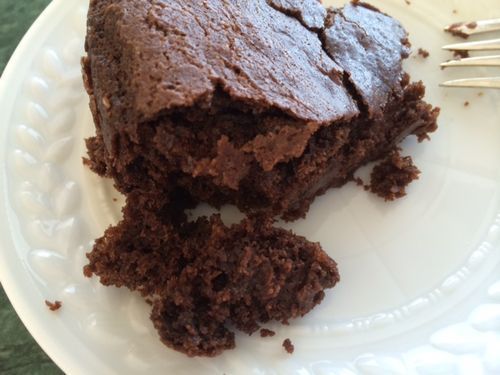
I was reading through Laurie Colwin's More Home Cooking yesterday, when I came upon this cake. I've been looking for an alternative to Angel Food Cake - which has virtually no fat - and this one seemed possible. It has no butter and no eggs, and requires only a half cup of oil and a cup of buttermilk. Then I saw the recipe was from the Fannie Farmer Cookbook, Marion Cunningham's revision of the classic, as tweaked by a friend of Laurie's named Karen Edwards.
So this is a chocolate cake that was passed down from Farmer to Cunningham to Colwin to Reichl.
It's not the most spectacular chocolate cake I've ever baked, but it certainly is the easiest. It takes all of three minutes to whip up, requires only one bowl, and spends a mere half hour in the oven. If you're in need of a delicious dessert at the last minute, this will make you (and your family), very happy.
Fannie, Marion, Karen, Laurie and Ruth’s Supersimple Chocolate Cake
1 3/4 cups all purpose flour
3/4 cup unsweetened cocoa powder
1 cup sugar
1 teaspoon baking soda
1/4 teaspoon salt
1 cup buttermilk
1/2 cup vegetable oil
2 teaspoons vanilla
Preheat the oven to 350 degrees.
Butter and flour a 9-inch round cake tin.
Mix the flour, cocoa, sugar, baking soda and salt in a medium size bowl.
Whisk in the buttermilk, oil and vanilla.
Turn into the cake pan (the batter will be fairly thick), and bake about 30 minutes, or until a tester comes out clean.
Put on a rack and allow to cool for a few minutes before turning out of the pan.
March 23, 2015
A Pretty Perfect Dinner
This is Kyle Knall, the chef at Maysville in New York. Last night he and BBQ Pitmaster John Markus cooked dinner for a small group at John's upstate house. It was a wonderful meal in every way, but the biggest surprise was that these meatcentric men, who spent all day grilling and smoking in a wicked wind, included so many fantastic vegetables in the mix. We ate (and drank) for hours, and yet somehow walked out the door feeling buoyant.
The evening began with this stunningly delicious concoction of razor clams:
And these tender lamb ribs. Kyle cooked them sous-vide before grilling them, then slathered the meat with a pungent cilantro sauce. They were irresistible - and just the start, just enough to stave off hunger while we waited for the main events.
And now the stars of the show. This remarkable quail, which Kyle marinated in sunflower seed hozon, before grilling them and adding a mustard seed accent.
A rabbit roulade - grilled. I thought it wouldn't stand up to the heat. I was wrong.
John's amazing slow- smoked beef rib (look at that smoke ring!):
Carrots!
Local grains from Wild Hive, topped with greens, mushrooms and various vegetables.....
and this stunningly simply salad of pea shoots, lemon, salt and a smattering of grated cheese.
For dessert, a very simple granita. And then, the perfect ending: the latest offering from Pinhook: a truly fantastic bourbon.
Ruth Reichl's Blog
- Ruth Reichl's profile
- 2980 followers


